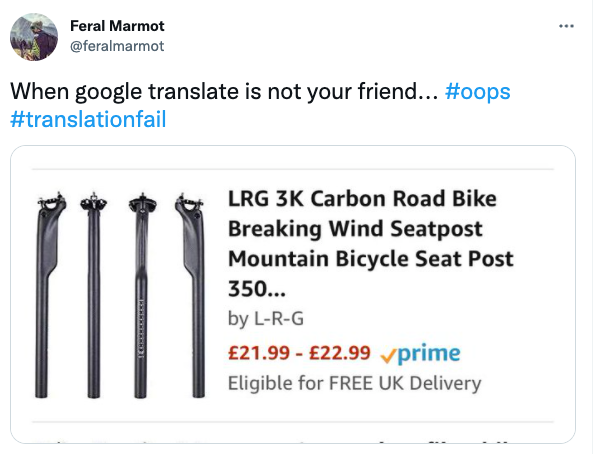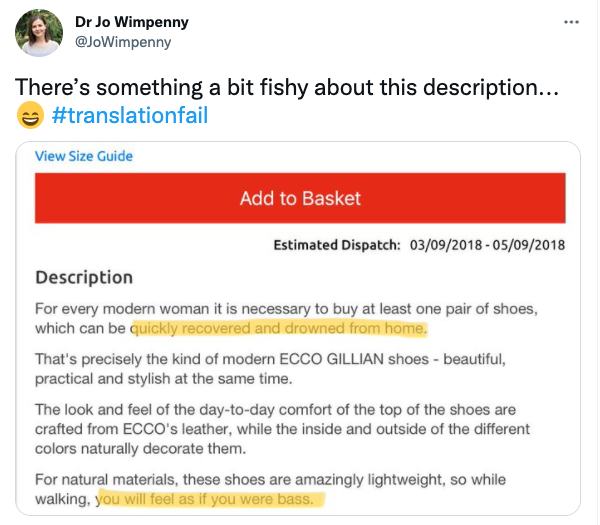Are These Translation Fails Hilarious or Disastrous?
You have probably gotten a few good laughs out of #translationfails — but they’re no laughing matter if your brand becomes the butt of the joke.
Seriously, poorly translated content can be disastrous to a business. It may fail to resonate with the target market, offend your audience, and damage your brand image. Inaccurate translation could even get you into legal trouble.
Let’s look at 7 most common types of translation fails. A good chuckle aside, we’ll discuss why they fail and what you can learn from them to avoid making the same mistakes.
Localization Rule #1: Don’t Rely on Machine Translation
Translating a product is way trickier than punching in a few words into Google Translate and watching magic happen. While machine translation (MT) technologies have come a long way, relying on them alone to localize your website, software, game, or app is a recipe for disaster.
Successful localization requires more than run-of-the-mill translation. The complex process demands careful adjustment of each element to address the local culture, audience preferences, colloquialisms, slang, and more to communicate the original intent of the message and the emotional appeal of the content.
MT services fail to grasp these critical nuances, which can only be captured by skilled professional translators who have a solid understanding of the target language, local market, and subject matter.
Translation fails often happen when businesses play fast and loose to cut costs or get products out the door quickly. They over-rely on MT services and neglect to have professional linguists post-edit the content to ensure high-quality and accurate translation.
Are These Translation Fails Hilarious or Disastrous? You Be the Judge
Here’s what we can learn from 7 common types of translation fails:
Amazon Listing Wants You To “Break Wind”
When sellers post many products, it’s tempting to run product listing copy through an MT program and call it a day. A bike part was translated into “Carbon Road Bike Breaking Wind Seatpost” on the Amazon UK site — not a confidence-inducing name at all!
Sure, time is often of the essence when you bring a product to market, but it’s not an excuse to skimp on quality assurance (QA). Build sufficient time into your project plan for QA and use a localization platform to help you test and track issues efficiently to ensure that nothing falls through the cracks.

Website URL Goes X-rated
An Italian company, Powergen, launched an international website with a .com domain but wanted to acknowledge its country of origin. It purchased the domain name powergenitalia.com but, thankfully, recognized the mistake in time to avoid a lot of embarrassment.
This example shows how a localization project involves more than translating content on a website. Consider everything your audience encounters while interacting with your brand. A poor URL choice may not sound like much, but the rework could get costly if the company went ahead and created printed materials, social media profiles, online ads, etc., based on it.
Product Description Gets Fishy
A product description on an e-commerce website read, “For every modern woman it is necessary to buy at least one pair of shoes, which can be quickly recovered and drowned from home… so while walking, you will feel as if you were bass.” Would you buy from this merchant?
Poorly translated content can diminish visitors’ trust in your brand. A pair of shoes may not be a big deal, but what if you sell software that handles sensitive information such as financial data? A mishap in your translated content could be costing you a lot of sales.

Video Game Character Named “Error”
Zelda II: The Adventure of Link was one of the first video games that introduced many non-player characters (NCPs) and, therefore, more dialogues. Error is a character whose line was “I am error.” This translation blunder has a happy ending: fans loved it, and the quote made its way into other games, such as Super Paper Mario.
Translating video games is challenging as storylines and dialogues become more complex. You must use the appropriate expressions and local references to communicate the essence and emotional appeal of the narrative. Moreover, many gamers prefer to use original character names, especially in multi-player games.

Product Naming Went Very Wrong 🤦
If you think big brands have it together, think again. Ford decided to keep the name of the Pinto in Brazil, which means “small male genitals” in Brazilian Portuguese. Honda launched Fitta in Sweden, not realizing that it’s a defamatory word associated with a woman’s genitals. Big Mac was translated to “Gros Mec”, meaning “Big Pimp” in France.
Companies could have easily avoided these issues if they consulted a local team. When localizing a new product, involve a local linguist early in the process to avoid obvious mistakes that’d be costly to correct down the road.
Taglines That Are Memorable, But Not in a Good Way
Taglines are supposed to be catchy, but you don’t want the wrong kind of attention! Pepsi’s upbeat “Come alive with Pepsi” tagline was translated into “Pepsi brings your ancestors back from the dead” in the China market. Meanwhile, the “Got Milk?” campaign turned into “Are you lactating?” in Mexico.
These translation fails are a good illustration that localization must account for how languages are used in each locale and address cultural nuances. Again, hiring a local consultant will help you avoid these glaring mistakes that can impact your brand image and diminish your credibility in a new market.

Healthcare FAQ Says Vaccine “Not Needed”
The Department of Health in Virginia reportedly used Google Translate to translate its website’s coronavirus FAQ section from English to Spanish. The official English website says “the vaccine is not mandatory,” but it became “the vaccine is not necessary” in Spanish.
Using MT services alone for critical information and technical documentation, especially in a highly-regulated industry, is definitely ill-advised. You may even get into regulatory hot waters! Even if you leverage the power of MT technologies, you must have a skilled linguist review the translation before publishing the content.
Translation Fails Aren’t Laughing Matter
Whether you’re launching a website, software, app, or video game in an overseas market, don’t skimp on translation and localization — which is the key to protecting your brand image, building trust with the local audience, delivering an outstanding user experience, and expanding market shares.
Of course, there’s no 100% airtight way to avoid translation mistakes. But there are many ways to minimize them.
Back to rule #1: don’t rely on machine translation alone. If you want to take advantage of MT technologies, hire a professional translation agency that meets the ISO 18587 standard for machine translation post-editing to help ensure the accuracy of the final content.

Besides hiring professional translators who understand the local audience and the subject matter, you should provide accurate, comprehensive, and concise source materials. For example, when translating a video game, send translators a summary of the storyline and background of each character so they can capture the emotional appeal of the narrative.
When you work with an experienced localization services provider, it can offer insights on the target language, context, and culture to help you nail your message. It’ll also provide the technology you need, such as a translation management system (TMS), to handle complex materials to achieve high-quality translation.
OneSky is an all-in-one localization solution designed for projects with many moving parts, such as software, apps, websites, and video games. It can help you streamline the process and make sure nothing falls through the cracks.
Besides all the necessary features, such as translation memory, TMS, term glossaries, workflow automation, string context, and more, the platform includes systems to evaluate localized content, test it on various devices, and track QA and bug fixes. You can also access a dedicated translation manager, plus over 1,000 professional translators fluent in 50+ languages to make localizing your product as painless as possible.
Try OneSky for free because #translationfails are no joke.



 Written by -
Written by - 


 Written by
Written by 


